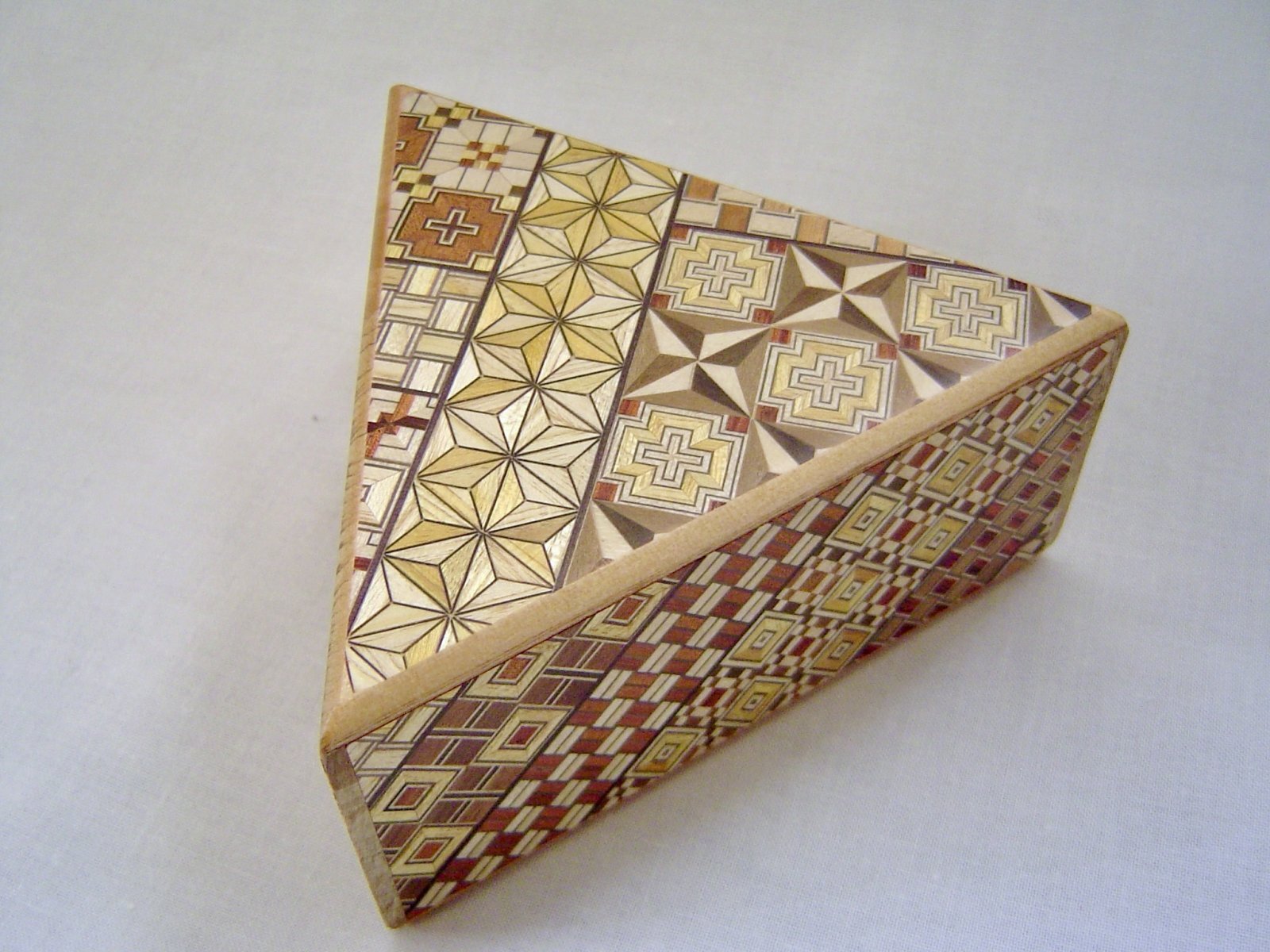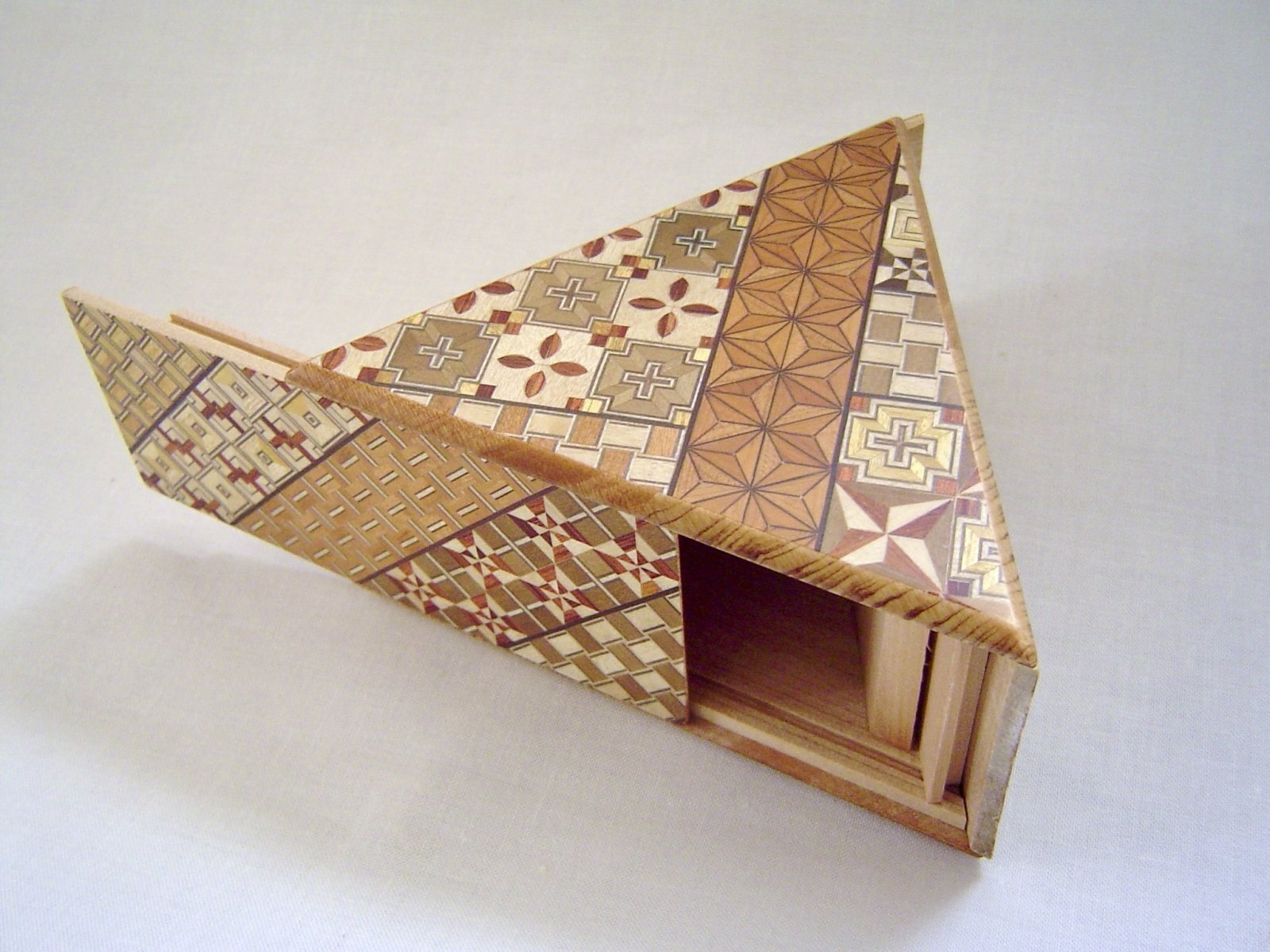Triangle puzzle box
Today, I would like to introduce one of my past works. I have received a commission from the Hakone market for triangular Japanese puzzle boxes as my next project, so I will showcase a different version of a triangular puzzle box that I made previously.
The triangular puzzle box that I've been commissioned to create by a Hakone dealer is more intricate. The one I made before was a type where the side panels opened, similar to hexagonal and pentagonal secret boxes. In contrast, the Hakone version of the triangular box has a 'Kannuki' mechanism and opens with a 7-step mechanism, similar to the standard square 7-step puzzle box. Although it has only 7 steps, making it is quite different from the usual 7-step box. Since it’s a 7-step mechanism, two sides of the box move and open, but because it's triangular, the mechanism has to be supported by the remaining one fixed side. Furthermore, while the two moving sides typically meet at a 90-degree angle, in the triangular version, they meet at a 30-degree angle, making it difficult to calculate the distance the sliding panels need to move. It's almost impossible to precisely calculate the dimensions, so I adjust them as I go. Compared to the type I usually make, the one with the 'kannuki' requires more intricate movements to open.
In comparison, my triangular version is much simpler😅(photos). For those familiar with my hexagonal box, it's the same mechanism where one side moves and then triggers the next side to move. Each side holds the next in place, and once one moves, the next follows. It's similar to the 4-step mechanism found in a standard square puzzle box. The pentagonal and hexagonal boxes have more sides, so the more sides, the more steps there are to open it. But since the triangular version only has 3 sides, it opens with a 4-step mechanism, just like a 4-step puzzle box. And in this triangular box, all three sides move. In that sense, it might even be a better deal than the Hakone version🤣
The apex of this triangular box is very sharp at 30 degrees, so I need to be cautious during processing. It’s prone to chipping, so I always use sharp tools for the job. While the sharp edges at the corners and along the sides enhance the beauty of the triangular shape, they could be painful when handling and moving the mechanism. Therefore, I gently round them off with sandpaper without compromising the aesthetic. This triangular box (the Hakone version) is limited to a 7-step mechanism because it’s difficult to increase the number of steps. However, since it requires more effort, it is priced higher than a typical 7-step box. As a result, its sales don’t seem to be particularly strong, but it's an interesting box, so I receive bulk requests for it every few years. I believe it’s one of those boxes that I’ll continue to make in the future.
The triangular puzzle box that I've been commissioned to create by a Hakone dealer is more intricate. The one I made before was a type where the side panels opened, similar to hexagonal and pentagonal secret boxes. In contrast, the Hakone version of the triangular box has a 'Kannuki' mechanism and opens with a 7-step mechanism, similar to the standard square 7-step puzzle box. Although it has only 7 steps, making it is quite different from the usual 7-step box. Since it’s a 7-step mechanism, two sides of the box move and open, but because it's triangular, the mechanism has to be supported by the remaining one fixed side. Furthermore, while the two moving sides typically meet at a 90-degree angle, in the triangular version, they meet at a 30-degree angle, making it difficult to calculate the distance the sliding panels need to move. It's almost impossible to precisely calculate the dimensions, so I adjust them as I go. Compared to the type I usually make, the one with the 'kannuki' requires more intricate movements to open.
In comparison, my triangular version is much simpler😅(photos). For those familiar with my hexagonal box, it's the same mechanism where one side moves and then triggers the next side to move. Each side holds the next in place, and once one moves, the next follows. It's similar to the 4-step mechanism found in a standard square puzzle box. The pentagonal and hexagonal boxes have more sides, so the more sides, the more steps there are to open it. But since the triangular version only has 3 sides, it opens with a 4-step mechanism, just like a 4-step puzzle box. And in this triangular box, all three sides move. In that sense, it might even be a better deal than the Hakone version🤣
The apex of this triangular box is very sharp at 30 degrees, so I need to be cautious during processing. It’s prone to chipping, so I always use sharp tools for the job. While the sharp edges at the corners and along the sides enhance the beauty of the triangular shape, they could be painful when handling and moving the mechanism. Therefore, I gently round them off with sandpaper without compromising the aesthetic. This triangular box (the Hakone version) is limited to a 7-step mechanism because it’s difficult to increase the number of steps. However, since it requires more effort, it is priced higher than a typical 7-step box. As a result, its sales don’t seem to be particularly strong, but it's an interesting box, so I receive bulk requests for it every few years. I believe it’s one of those boxes that I’ll continue to make in the future.

